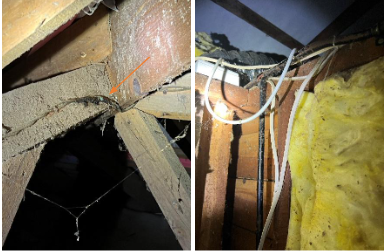Building Basics – Electrical
Across our Building Basics series, we’ve covered everything we look for in a pre-inspection, from the roof to the foundations. As with our blog on plumbing last time, your potential purchase’s electrics and wiring may be hidden in walls and ceilings. Unfortunately, out of sight does not mean peace of mind… It pays to have a thorough inspection of any possible hazards before you sign on the dotted line.
Age and stage
New Zealand has many homes which are old, with electrical wiring which is dated and might not be safe. Old wiring is unlikely to meet current NZ Electrical standards, so your property inspector will be on the lookout for a few tell-tale signs, including:
- the era of the property (when it was built),
- the type of wiring in use, and
- what the switchboard looks like.
Old wiring

and burnt out is commonly run in
If your wiring is over 60 years old, there’s a good chance you might need to replace it. The first type of wiring used is called Vulcanized Indian Rubber or VIR. This is commonly run in a steel conduit or wooden casing. From around 1940 to the late 1960s, a rubber coated electrical wire was commonly used to insulate wiring. This is called Tough Rubber Sheath wiring or TRS for short. Both of these types of wiring have been found to deteriorate over a period of time which can lead to an increased fire risk. It’s important to point out that an insurance company might decline to insure your property if the wiring is old or not fit for purpose – a great reason to get it checked. Exposed or deteriorated wiring is also an electrocution hazard.
In an older property, it’s likely that over the years, some (if not all) of the wiring has been replaced. Your property inspector will be checking that it’s fixed off properly i.e., not loose, in the ceiling or sub-floor. They’ll also be checking that it’s free from water and pest damage, something that might be more common with older rubber-coated wires. Ideally when an electrician replaces the older wiring they remove it so there is no risk of anyone accidentally making them ‘live’ in the future.
Circuit board or switchboard

wires at back should not switchboard meter box, some fuses have been
be accessible changed for circuit breakers
Every home runs dozens of appliances which suck up power, like big fridge freezers, dishwashers, dryers, heat pumps, induction cookers, and microwaves. The load we are putting on our wiring and switchboards today has increased dramatically, but it can be too much on a switchboard that is no longer fit for purpose. The circuit board is there to protect your appliances and ensure a smooth ‘delivery’ of electricity without cutting out or causing light to flicker.
Without steady conduction, there’s a chance using too much electricity can cause fuses to blow, or circuit boards to ‘trip’. In some cases, there’s a risk of fire. Imagine you’re in the middle of a dinner party, entertaining friends, and the lights go or the hot water cylinder fails. Changing the fuse in an old switchboard (involving ceramic plugs and wire) is time consuming, fiddly, and dangerous if you don’t know what you’re doing.
Your property inspection report will include the age and condition of your switchboard and whether it is the old ‘fuse’ type of board, or a newer circuit breaker one. Many switchboards will be original to the property. Some aren’t easily accessible. Renovations or alterations over many years can mean past owners haven’t bothered to move the switchboard – we’ve even seen kitchen cabinets built around one!
Note: some older switchboards might contain asbestos, which is handy to know. This can add to the cost of replacement. While they might not need replacing right away, they make ‘modern living’ with our dedication to technology and gadgets a bit more difficult!
Switches and fittings
Other warning signs that your home requires rewiring can be the state of the switches and fittings. We’ll test the power sockets and be on the lookout for brown scorch marks, broken fittings, or loose wires.
If you’re in the market for a new home, make sure you read back over our Building Basics series. When purchasing a property, there’s a large list of things that need to be checked over. If your property report highlights any electrical red flags, we recommend getting an electrician to check off if you need any imminent or future repairs. Go into your next purchase with your eyes wide open. For true peace of mind, book your comprehensive pre-purchase inspection with us today on 027 2939 808.







